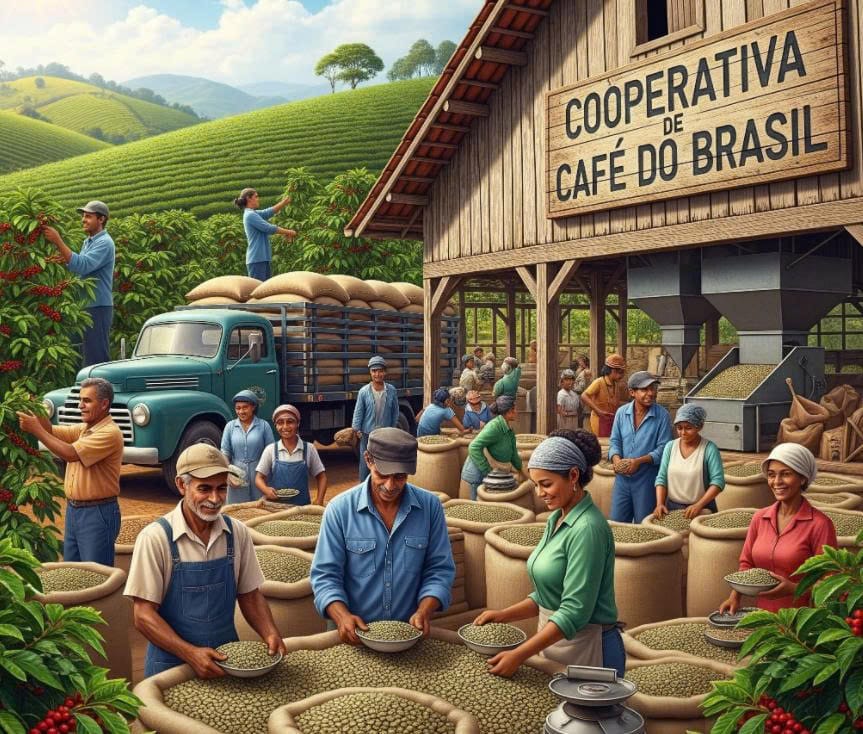In 2025, declared by the UN as the International Year of Cooperatives, the cooperative movement in Brazil’s coffee sector is taking center stage. With more than 4,500 cooperatives in the country—97 of them dedicated to coffee—these organizations play a crucial role in the production, marketing, and export of the product.
One of the leaders of this movement is Marco Valério Brito, president of Coccamig (Central Cooperative of Coffee Growers and Livestock Farmers of Minas Gerais), which is celebrating its 40th anniversary this year. Born in Três Pontas (MG), Brito has dedicated much of his life to coffee, combining experience in the financial market with agricultural production and cooperative management.
In a conversation with Espresso, Brito analyzes the current state of coffee growing, the challenges of the cooperative movement, and Brazil’s new positioning in the international coffee market.
Question: When did your story with coffee begin?
Marco Valério Brito: I was born in Três Pontas and grew up on a coffee farm. Later, I studied in Belo Horizonte and worked in the financial market, which led me to become interested in the New York Stock Exchange and the coffee futures market. Then I worked at the Ministry of Industry and Commerce, in the newly created National Coffee Department. In 2014–2015, I decided to leave finance, bought a coffee farm, and took on the presidency of Cocatrel for nine years. Later, I joined Coccamig.
Q: How do you see the relationship between coffee and cooperativism?
MVB: They are inseparable. Coffee, unlike other commodities, requires a high level of professionalization and financial support. Most producers are small, and multinationals cannot easily reach all regions. Cooperatives fill that gap, facilitating logistics, financing, and market access.
Q: What are the key principles of a strong cooperative?
MVB: Transparency, professionalization, and succession planning. Without clear data, audits, and management systems, a cooperative will be out of the market. At Coccamig, we promote courses and training so producers understand how the market works and the importance of honoring commitments.
Q: Coccamig brings together 17 cooperatives. How can you prevent large ones from absorbing small ones?
MVB: We promote fairs, joint exports, and international missions that give visibility to smaller ones. This way we preserve the identity of specific regions such as Canastra or Mantiqueira, avoiding the loss of their history when incorporated by large cooperatives.
Q: What benefits does inter-cooperation generate?
MVB: One example is our fertilizer purchasing center, which achieved an 18% price reduction. This model applies to other inputs and services, generating savings and efficiency.
Q: How have cooperatives evolved in these four decades of Coccamig?
MVB: Governance has improved greatly. Today we have clearer processes, technical training, and more professional management, which strengthens future prospects.
Q: The EU’s Anti-Deforestation Law (EUDR) will come into force at the end of 2025. What impact will it have?
MVB: We are training our cooperatives in traceability and carbon neutrality. Cooperatives have the capacity to lead compliance with these requirements, showing the environmental value of Brazilian coffee farming.
Q: What is the “new order” in coffee exports?
MVB: Since 2010, cooperatives have become much more professional. With recent crises—pandemic, wars, logistical problems—Brazil has assumed global leadership, and cooperatives are the driving force behind this change, aligning with ESG principles, compliance, traceability, and carbon neutrality.
Q: Does the current price scenario favor cooperatives?
MVB: Yes, because they control inventories and can negotiate better. However, the market is highly volatile and requires careful hedge management.
Q: Will high prices be sustained in 2025?
MVB: It will depend on factors such as climate, harvests in Colombia, Vietnam, and Africa, and global logistics. The current market does not follow historical references, and supply remains concentrated in producing countries.
Q: Can high prices affect domestic consumption?
MVB: There may be a drop in traditional coffee consumption, but there is room for quality coffees at affordable prices and sustained growth of specialty coffees.
Q: Regarding Asia, how do you see the opportunity in China?
MVB: It’s a key market, but competition will be tough, with countries like Uganda and Peru receiving heavy investment and signing strategic agreements with China.
Q: What is Brazil’s biggest challenge?
MVB: Port logistics. We have excellent quality coffee and strong governance, but infrastructure remains a bottleneck that slows our competitiveness.
Q: How can cooperativism be made more appealing to young people?
MVB: By modernizing communication and strengthening our presence on social media. Cooperativism is not something from the past; it’s a tool to build the future.
Q: What are your goals as president?
MVB: To sustainably raise the price of Brazilian coffee, improve the quality of life in producing communities, and strengthen the role of cooperatives in the global market. For 2025, the goal is to maintain professionalism and demonstrate, through external audits, the sustainability and traceability of Brazilian coffee.

